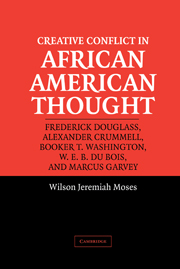Book contents
- Frontmatter
- Contents
- Acknowledgments
- Preface: Struggle, Challenge, and History
- 1 Introduction: Reality and Contradiction
- FREDERICK DOUGLASS: THE INDIVIDUALIST AS RACE MAN
- ALEXANDER CRUMMELL: THE ANGLOPHILE AS AFROCENTRIST
- BOOKER TALIAFERO WASHINGTON: THE IDEALIST AS MATERIALIST
- W. E. B. DU BOIS: THE DEMOCRAT AS AUTHORITARIAN
- MARCUS MOZIAH GARVEY: THE REALIST AS ROMANTIC
- 13 The Birth of Tragedy: Garvey's Heroic Struggles
- 14 Becoming History: Garvey and the Genius of His Age
- CONCLUSION: RESCUING HEROES FROM THEIR ADMIRERS
- Index
13 - The Birth of Tragedy: Garvey's Heroic Struggles
Published online by Cambridge University Press: 07 November 2009
- Frontmatter
- Contents
- Acknowledgments
- Preface: Struggle, Challenge, and History
- 1 Introduction: Reality and Contradiction
- FREDERICK DOUGLASS: THE INDIVIDUALIST AS RACE MAN
- ALEXANDER CRUMMELL: THE ANGLOPHILE AS AFROCENTRIST
- BOOKER TALIAFERO WASHINGTON: THE IDEALIST AS MATERIALIST
- W. E. B. DU BOIS: THE DEMOCRAT AS AUTHORITARIAN
- MARCUS MOZIAH GARVEY: THE REALIST AS ROMANTIC
- 13 The Birth of Tragedy: Garvey's Heroic Struggles
- 14 Becoming History: Garvey and the Genius of His Age
- CONCLUSION: RESCUING HEROES FROM THEIR ADMIRERS
- Index
Summary
Cast the Bantling on the rocks,
Suckle him with the she-wolf's teat,
Wintered with the hawk and fox
Power and speed be hands and feet.
EmersonLiterary historians recognize a linkage in classical tradition between the epic, the tragic, and the heroic – terms that arise naturally in a discussion of Marcus Garvey. The heroic genre centers always on a struggle that may be resolved either in Achilles's epic triumph or in Hector's tragic defeat. The story of Garvey necessitates the tragic mode; it contains only the possibility of defeat. Tragedy relates the history of a noble, but flawed individual, a hero who is superior to the average person and confronted by irresistible forces. As in the above epigraph taken from Emerson's essay “Experience,” tragedy combines archetypal elements; in more than one classic narrative, a bantling is exposed among the rocks, struggles against a world of lupine ferocity, then, proving himself by means of a series of invigorating struggles and a vulpine cunning, soars triumphantly to the pinnacle of fame, only to be humiliated and destroyed as Garvey was.
Heroism is in no way diminished when the hero's struggles lead to the inevitable agony of defeat. Tragedy implies a deterministic universe, as in a Greek drama where the audience knows from the outset that an action is moving toward its only possible conclusion.
- Type
- Chapter
- Information
- Creative Conflict in African American Thought , pp. 231 - 255Publisher: Cambridge University PressPrint publication year: 2004



